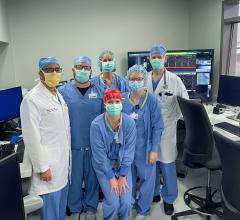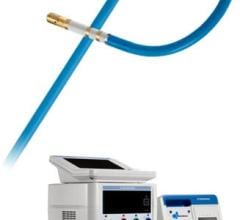
October 12, 2012 — Estech, a provider of minimally invasive cardiac ablation devices, last month announced the market release of its Cobra Fusion ablation system. This technology is the first of its kind to use a unique suction application and innovative electrode configuration to gently pull the tissue targeted for ablation into the device and out of the path of circulating blood. The Cobra Fusion ablation system overcomes the most significant challenge faced in minimally invasive epicardial ablation, the cooling effect of the circulating blood inside the heart, and reproducibly creates transmural (full-thickness) lesions on a beating heart. This bipolar clamping technology in the form of an epicardial catheter is thus capable of creating linear lesions anywhere on a beating heart with unprecedented performance and ease of use.
The Cobra Fusion ablation system incorporates proprietary Versapolar technology — an exclusive innovation that delivers both bipolar and monopolar radiofrequency (RF) energy to the targeted cardiac tissue, enabling transmural lesion formation in thin and thick cardiac tissue. As with all Cobra ablation systems, the new device is powered by Estech’s patented temperature controlled radiofrequency (TCRF) energy, which continuously monitors and maintains tissue temperature at target levels throughout the procedure. TCRF avoids the need for multiple applications that other technologies often require and ensures that tissue temperatures remain within a safe and effective range.
“I have had the recent opportunity to observe the clinical use of this new device in several patients. The historical problem of attaining atrial wall transmurality reliably in a beating, working heart by applying ablative energy from only the epicardium appears to have been solved with this new device,” said James L. Cox, M.D., creator of the Cox-Maze procedure and the Evarts A. Graham professor of surgery emeritus and chief of the division of cardiothoracic surgery emeritus at Washington University School of Medicine, Barnes-Jewish Hospital, St. Louis.
“The ability to involute the atrial wall into the ablation device itself using suction allows for the application of [RF] energy to both sides of the involuted tissue, thereby creating reproducible transmural and contiguous linear lesions for the first time off-pump. Moreover, the device is small enough to fit through a standard port, using an endoscopic port-access approach. I believe that this device represents a significant addition to the surgeon’s armamentarium in the field of cardiac ablation,” added Cox.
The Cobra Fusion is the result of several years of research and development, and has been extensively tested in several labs including the prestigious research lab at Washington University in St. Louis. “We have evaluated this new device in our animal lab and were very impressed with the results. It is an innovative device that has the potential to facilitate minimally invasive surgical ablation. It is likely to advance the field by improving lesion formation on the beating heart,” said Ralph J. Damiano, M.D., the John M. Shoenberg professor of surgery and chief of cardiac surgery at Washington University School of Medicine.
The ablation system received U.S. Food and Drug Administration (FDA) clearance in April and CE mark in May, and has been in extensive clinical evaluations in the United States and European Union since then.
For more information: www.estech.com


 October 30, 2024
October 30, 2024 








